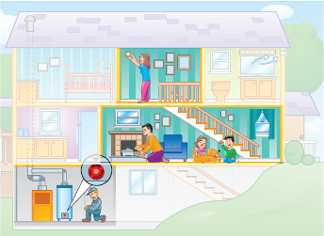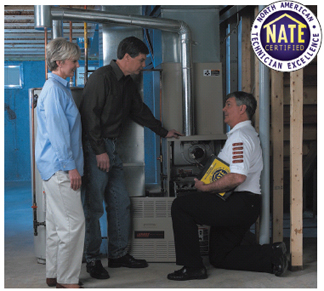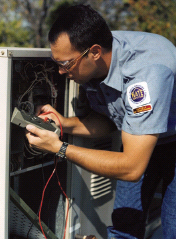
For instance, proper combustion and venting are important for an efficient and safe home appliance. Gas flow and mixing air contribute to proper flame shape and correct combustion. Bird or other animal nests; children's toys; and leaves, branches, and other yard debris can partially or completely block vents that can lead to inadequate venting.
One of the byproducts of burning natural gas is water vapor. Water vapor that is not properly vented and expelled outside a home can condense in the vent and lead to corrosion of the vent system. Over time, this can lead to failure of the venting system. This can introduce toxic gases into a home that otherwise would be vented to the outside air. Vent corrosion can also lead to a shorter-than-expected service life of a gas appliance.
Another big concern is carbon monoxide (CO), a colorless, odorless, tasteless gas that is formed when carbon-based fuels - such as kerosene, gasoline, propane, natural gas, oil, charcoal, or wood - are burned with inadequate amounts of oxygen, creating a condition known as incomplete combustion. In the case of home gas appliances, this can be caused by improper installation, poor maintenance, or other appliance misuse or failure. When incomplete combustion occurs in a home's gas appliances, CO is produced, and this can lead to carbon monoxide poisoning.
The bottom line is this: A qualified and licensed technician is needed. The Gas Appliance Manufacturers Association (GAMA) recommends to consumers that they seek a tech certified by the North American Technician Excellence (NATE), someone who is trained to recognize and correct problems when servicing a home's gas appliances.
"Most consumers know very little about HVAC," said Carl Smith, director of marketing and public relations for NATE. "By saying you are knowledgeable and you can prove it, then you are a known quantity. Certified means you know all about heating and air conditioning. At least there is this third-party verification of your knowledge. It gives you more validity. It is a reassurance to the consumer that you are knowledgeable and you will not take advantage of the consumer."

MAINTENANCE: WHAT TO LOOK FOR
A homeowner may not know that a bright blue flame indicates that a gas appliance is operating correctly. A clean flame also means an appliance is efficiently burning and properly adjusted.If a homeowner suspects an appliance is not operating properly, a qualified technician should be called. A qualified and licensed service tech can supply the following services:
In short, a certified tech can provide the peace of mind consumers and homeowners seek and want.

NATE CERTIFICATION
To earn NATE certification, for instance, a technician must pass both a core and a specialty test in the same area with a grade of 70 percent or higher on each. There are 50 questions on core tests and 100 on specialty tests. When a technician passes both a core and specialty test, the technician is sent a wallet card reflecting the certifications earned or credited, a certificate for the certification earned, and a NATE patch and specialty chevron for the test passed.If a technician fails one of the two tests, certification is not awarded until the candidate successfully retakes the test failed. The test the technician passed does not need to be retaken. Tests should not be retaken for 30 days from the original test date to give the candidate time to study and review.
Candidates must complete certification requirements within two years of the first test they passed, or they have to start over. Candidates who do not retake the test they failed lose credit for the test they passed if they do not successfully pass their retest within two years. If two years elapse, and they have not passed both tests, they must retake both.
"NATE-certified technicians are skilled, third-party-certified professionals, the best in the heating, ventilation, air-conditioning, and refrigeration industry," said Smith.
For more information on becoming NATE certified, visit www.natex.org.

MAINTENANCE: WHAT HOMEOWNERS CAN DO
While certified techs can supply the needed annual maintenance checkups, homeowners should also perform simple inspections of their systems by using the appliance manufacturers' maintenance instructions. These instructions may include information on:"Homeowners can also look for signs of problems by inspecting the ducts and venting systems of their gas appliances," said Phil Gauthier, one of the managers in technical services at GAMA.
Homeowners can look for:
According to Gauthier, homeowners should also make sure to properly replace the front panels of a forced-air unit or the burner compartment door of a gas wall heater.
"Most forced-air furnaces have a filter that cleans the heated air circulating through the home," said Gauthier. "The filter should be checked monthly for dust and lint buildup during periods of furnace use and cleaned or replaced if necessary."
When installing a new or cleaned filter, a homeowner should be sure to reinstall the front panel door of the furnace properly so it fits snugly. Never operate the furnace without the front-panel door properly in place because doing so may create the risk of carbon monoxide poisoning, said Gauthier.
"Most forced-air furnaces have a safety switch that prevents furnace operation when the door or panel to the blower compartment is not in place," said Gauthier. "Some older forced-air furnaces do not have a safety switch and can be operated with the filter compartment door/panel off or not properly in place. These older furnaces, when installed in a closet and operated with the panel/door not in place, will circulate carbon monoxide throughout the house."
MORE SAFETY MEASURES
In addition to routine maintenance:"If vent system repairs are necessary, have all gas appliances and venting repairs done by a NATE gas appliance/heating technician/contractor. This will assure the work is done properly, safely, and according to local and national codes," said Gauthier.
While the chance of injury or death from accidental carbon monoxide poisoning from a home gas appliance is rare, it is mostly preventable.
"It is essential to perform regular maintenance on home gas appliances to ensure safety," summarized Gauthier. "We recommend that gas appliances be checked at least once a year by gas service providers or other qualified and licensed technicians."
Publication date: 07/24/2006

Report Abusive Comment